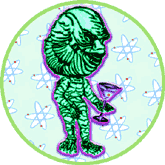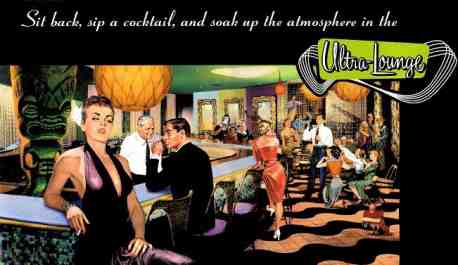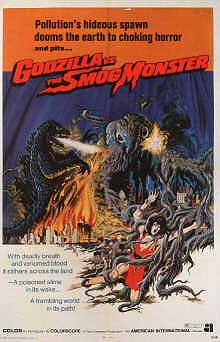


Get the COMPLETE SCOOP ON THE PROTEST - and my entire lifestory in general - in SILKE TUDOR'S SF Weekly column "Nightcrawler" |
![]()
By Will ("The Thrill") Viharo
Please see
SCHEDULE link for
updated ticket and
program info
THIS MONTH:
DRIVE-IN-TEGRITY: MONSTER MORALITY; YOUTHFUL ANGST, AND HIPPIE KUNG FU
The year is still in its diapers and Thrill seekers have already experienced some all-time Thrills in Thrillville. First there was the surprise special guest appearance of Mothra herself in January (see Scenes link, pg. 7). Then, there was that incredible moment on Valentine's Day when me and two hipsters from The Donkey Punch All Stars, Mick and Roffy, wearing vintage Mummy masks, appeared from the Parkway stage-wings waving our plastic hatchets just as the onscreen monsters attacked the curvy carnival dancers at the finale of The Incredibly Strange Creatures Who Stopped Living and Became Mixed-Up Zombies. The audience went absolutely nuts, clapping, cheering and screaming. Then special guest Ray Dennis Steckler, wearing his Cash Flagg hood, ran up on stage too, and it was a total riot. But right after that, the film broke. There I was, standing before a huge blank screen, literally roaring my disapproval. Fortunately Ray was there to entertain the crowd while the film was repaired, and then later I explained that a zombie had entered the projection booth, strangled the projectionist and hacked up the film. It was priceless - and the beauty of it was, the audience thought we had planned it that way! No, it was merely the magic of classic B movie cinema unfolding live before their astonished eyes, a spook show spectacular gone blissfully haywire.
These are sights that were once ubiquitous in our popular culture, the heyday being the 1940s, '50s and '60s, when drive-ins and grind-houses and neighborhood movie palaces were happily haunted by spooks, ghouls, magicians and other masked marvels trying to make a semi-honest buck. By every account, these experiences were cheap, fun, memorable, original and harmless. It was almost like a secret society back then, an underground culture unknown and untouched by the mainstream establishment. Then in the '70s, Hollywood realized there was a huge market out there for drive-in exploitation movies, once considered by the mainstream to be the wastebasket of cinematic distribution, and the Blockbuster was born: Jaws, Stars Wars, Close Encounters, Raiders of the Lost Ark. One colorful era abruptly ended, and another, blander era took its place, and is still in place today. Most people in their twenties grew up with this cold, calculated, heartless, revisionist film culture, which usurps the ideas of the past and polishes them up for the masses, but in wiping away the grime and dust they also removed the one element that made those throwaway B movies such immortal gems: their sincerity.
You can have all the Soderberghs and Spielbergs, with their dull, derivative, mainstream-mongering Filmmaking 101 conformity. Beyond their spontaneous nature, accidental time capsule atmosphere and low budget charm, what I appreciate most about the real drive-in movies of yore is their honesty. What I do not respect about most modern films and filmmakers is their dishonesty, trying to appeal to the mass libido in the guise of wholesome, safe entertainment. Case in point: Spielberg going back and replacing the FBI agents' guns with walkie-talkies in the 20th anniversary re-release of ET. When one feels they have to go back and digitally sanitize a piece of fluff like friggin' ET, you know the conservatives have won back the country's screwed up sensibilities. Well, to hell with Spielberg, Hollywood and the conservative mainstream, I say. Give me a good old-fashioned rubber monster chasing a half-naked screaming sexpot any day. Sure, this appeals to my base instincts, and is decidedly not "politically correct," but at least I admit it. We're all primitive beneath the civilized façade - even me, a sophisticated lounge lizard, acknowledges I originally crawled out from under a rock, and I haven't forgotten my roots. B movies are still popular because they are not ashamed to expose our "sinful" souls, supplying vicarious release for our darker impulses, but at the same time appealing to the innocent, awe-struck child in all of us, sans the big budget, all-star artifice of current Hollywood "thrillers." And every maker of low budget sleazeploitation I've ever met - Ray Dennis Steckler, Ted V. Mikels, Robert Clarke - was also one of the humblest, sweetest, nicest people I've ever met. They know the distinction between fantasy and reality. They know what cinema is truly for - to reflect our dreams and nightmares in a shared environment, so we can all confront and enjoy them collectively. They also know you can't always do this in real life, nor would you want to. That's the childlike element I love so much about B movies - they're products of and for pure, unadulterated imaginations.
This innocence is precisely what is missing from the direct descendants of the classic drive-in flick: the modern slasher movie, which began with Halloween and Friday the 13th and now gets parodied in recent hits like Scream. Slasher movies are too intense and neurotic to appeal to our inner child, which crawls deep inside of us to hide. Also, where's the imagination in sticking a goddamn hockey mask on some wacko? You call that "makeup"? You call that a "monster"? Where's the fun in that? Plus there are way too many serial killers on the Evening News for my taste already. I want escapism from my drive-in movies. That's why I prefer my protagonists in rubber monster suits. The unreality of them appeals to my childlike, but primordial, reveries.
Another interesting aspect of B movies is that, because of their subversive nature, they avoided the conservative mainstream radar altogether, and so radical filmmakers (like Roger Corman) were able to inject serious social commentary and rebellious themes into their little projects. The audience for these flicks was mostly composed of fringe dwelling misfits - artists, teenagers, bikers, freaks, perverts, druggies, as well as average racial and sexual minorities - who whole-heartedly embraced the message along with the mayhem. It was like an underground cinematic conspiracy.
 For instance, this month,
for a road show at San Francisco's premiere beatnik underground movie
nightclub, The Werepad, I am showing Buzz Bob
Ekman's 16mm Scope print of the 1971 Japanese monsterpiece GODZILLA
VS THE SMOG MONSTER (March 16). In this one, a camp favorite, the Big G
takes on the gloopy Hedora, a nuclear by-product of an abused environment. As
the Bush administration sneaks through its conservative agenda with the aid of
Fear, politically perpetuated by our clueless cowboy puppet prez, stuff like
environmental protection, women's rights, gay rights, Arts funding, etc. may
all go the way of the dinosaur. Come see the Original Lizard King strike back
and kick major ass! These kind of vicarious thrills may our only opportunity to
vent our frustration in the midst of the patriotic plague purging our country
of dissent and a balanced perspective. This flick is also famous for some
notorious period details - Godzilla was leaving the familiarity of the Atomic
Age and entering the way-out world of the 1970s. When an icon of a specific era
makes this sort of cultural transition, it's a weird spectacle, man. Also on
the thrill-bill that night, for the little kid inside of you, catch an original
SPEED RACER cartoon (also in 16mm) which reveals the origin of
Racer X. It's a Japanese Psychotronic Blowout, baby -
lotsa laughs and thrills, with a social conscience.
For instance, this month,
for a road show at San Francisco's premiere beatnik underground movie
nightclub, The Werepad, I am showing Buzz Bob
Ekman's 16mm Scope print of the 1971 Japanese monsterpiece GODZILLA
VS THE SMOG MONSTER (March 16). In this one, a camp favorite, the Big G
takes on the gloopy Hedora, a nuclear by-product of an abused environment. As
the Bush administration sneaks through its conservative agenda with the aid of
Fear, politically perpetuated by our clueless cowboy puppet prez, stuff like
environmental protection, women's rights, gay rights, Arts funding, etc. may
all go the way of the dinosaur. Come see the Original Lizard King strike back
and kick major ass! These kind of vicarious thrills may our only opportunity to
vent our frustration in the midst of the patriotic plague purging our country
of dissent and a balanced perspective. This flick is also famous for some
notorious period details - Godzilla was leaving the familiarity of the Atomic
Age and entering the way-out world of the 1970s. When an icon of a specific era
makes this sort of cultural transition, it's a weird spectacle, man. Also on
the thrill-bill that night, for the little kid inside of you, catch an original
SPEED RACER cartoon (also in 16mm) which reveals the origin of
Racer X. It's a Japanese Psychotronic Blowout, baby -
lotsa laughs and thrills, with a social conscience.
The 1950s are often maligned as an era of rampant conformity. The truth is, this is the decade when the fabric of conservatism began to unravel, thanks to Beat culture, drive-in movies, Rat Pack hedonism, and rock 'n' roll. The beauty of movies made during this period was that, while reflecting the restlessness of the nation's youth and left-leaning rebels, they also retained the charming innocence of an American than once had romantic ideals. The combination makes for some fascinating time capsules, and 1957's turgid teen drama ROCK PRETTY BABY (March 14, Parkway) was one of the first flicks to combine these conflicting ingredients. What makes this one particularly fascinating is its offbeat cast: John Saxon (known to later generations as the dad in the Freddy Kruger flicks), James Dean's sweet little sidekick Sal Mineo, Fay Wray (King Kong's babe), the poetic Rod McKuen, Edward Platt (the Chief on Get Smart), and Shelley Fabares (from the Donna Reed Show, pre-"Johnny Angel"). The music is by Jimmy Daley and the Ding-a-lings (???) and cool lounge cat Henry Mancini (!!!). It was such a hit that there was a sequel made, Summer Love. And I bet you've never seen either! Now's your chance - a rare 35mm print courtesy of those mad movie mavericks at The Werepad.
In the '60s, while drive-ins still flourished, rockabilly rebels and stylish swingers soon gave way to another movement, radically different in tone and style, but with similar goals of anti-authority: hippies. The difference between original hippies, like the ones in the counterculture classic BILLY JACK (March 28, Parkway), and contemporary hippies is that original hippies were actually making a statement with their bad fashion. They were rebelling against the clean-cut establishment. Many of today's grungy kids are just too lazy to take a shower or get a haircut. Even big businessmen look like slobs nowadays, and what are they rebelling against? I mean, aesthetically speaking, the hippie lifestyle is not my thing, but I respect purity of expression, and if looking like a slob defines your identity to the world, by all means, be a slob. Not everyone has the energy, wardrobe or panache to pull off the Rat Pack look, at least not on a daily basis. (I still try, though - but that's just me.) If you want to see what I'm taking about, check out this rare 35mm print of THE hippie kung fu classic, which is actually a sequel to Born Losers. Tom Laughlin (who made his debut in Robert Altman's first movie, The Delinquents, back in '57) immortalized himself and this strange twilight era in between the Summer of Love and the Dawn of Disco, when everyone seemed stoned and didn't know what the hell was going on, so they just winged it. It was a kind of surreal, dopey pandemonium. Everything was falling apart, the whole social structure was shot to hell, but people were still partying, protesting and procreating. Billy Jack is an ex-Green Beret who decides to put his karate expertise to good use - defending the rights of hippies, horses and hedonists. This homemade hit features his real life wife Dolores Taylor and the hit song "One Tin Soldier"! Laughlin distributed this movie himself, four-walling it in theaters around the country. He stuck a nerve deep in the social conscience of drive-in moviegoers everywhere, cleaning up at the box office and making a defiant statement at the same time.
God bless B movies. We need them now more than ever.
NEXT MONTH: MUTANT AFRICAN WASPS AND HORNY JUPITER BABES
Please see
SCHEDULE link for
updated ticket and
program info